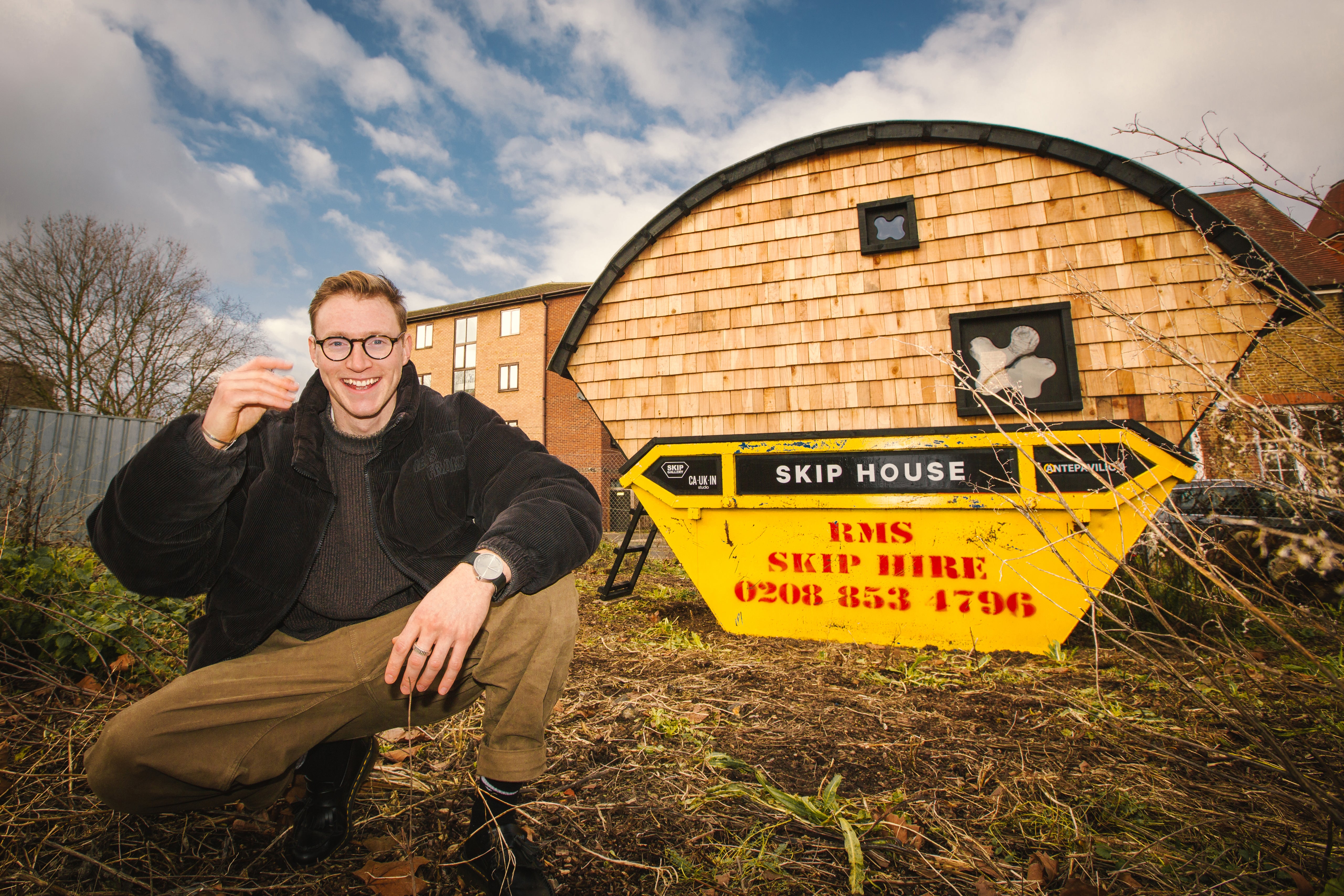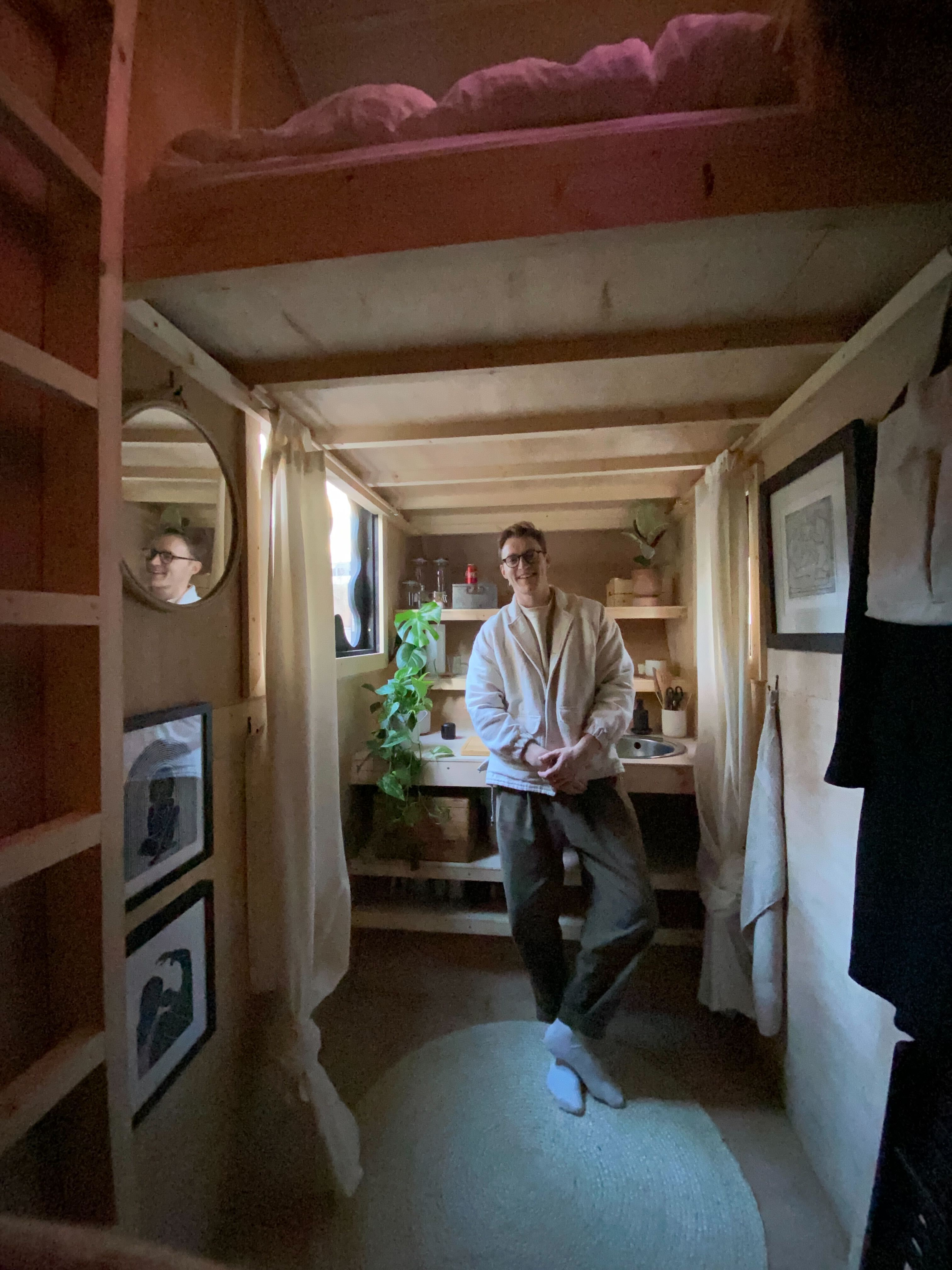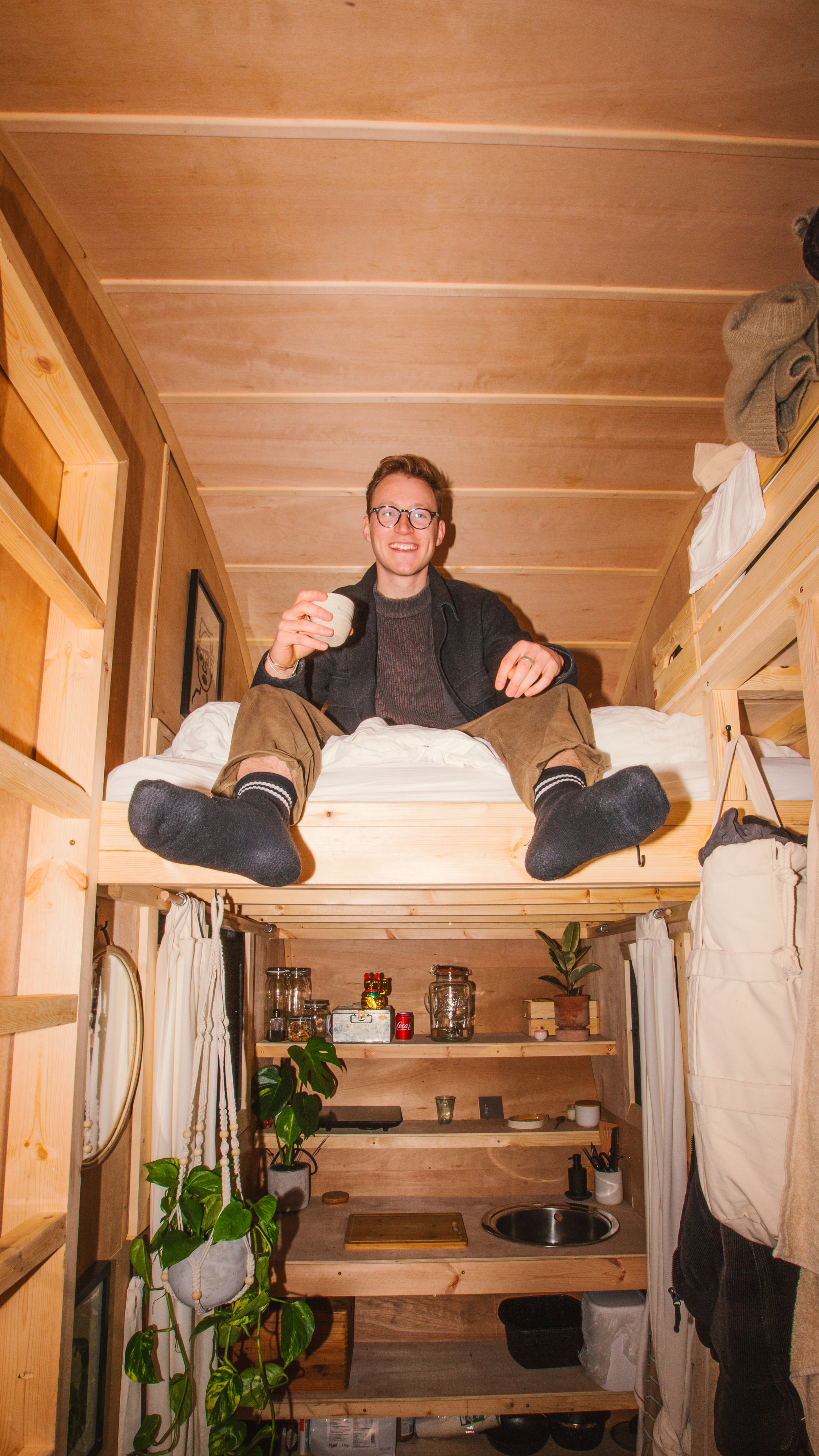I’ve lived in a skip for a year – this is what it has taught me about life
When Harrison Marshall moved into a converted skip in London, it was a bold statement about the impact of the cost of living crisis on young people like him who need somewhere affordable to live. A year on, he is amazed at how he has adapted to his new home, and explains why he’s not giving it up – despite the effect on his love life

When I was a kid, I used to build dens. My friends and I would find little nooks, hidden corners, in Brighton where I grew up, and make them into secret hideouts just for us. Ever since I was young, I’ve always been obsessed with tiny spaces and structures. Did I think that would naturally lead to me living in a skip at 28? No.
I also didn’t expect that my converted skip, close to London Bridge station, would turn out to be the best place I’ve ever lived in this city. The construction is 3.5 metres high, and 4.35 metres wide at its broadest point, with a pine frame clad in cedar shingles and a roof consisting of recycled plastic combined with aluminium on top.
This month will mark one year since I moved in, and I don’t regret a thing. Perhaps that sounds surprising, but in the midst of our current housing crisis, it’s actually not that far-fetched. Just this week, the chair of NatWest, Howard Davies, made headlines for declaring that it’s not “that difficult” to get on the property ladder, ignoring the fact that, across England, a house now costs more than 10 times the average salary.
On top of that, rent in the capital has gone up by 31 per cent in two years, and now takes up 42.5 per cent of the average income, making saving near impossible. The shortage of affordable homes – which a succession of governments have either neglected to build, sold off, or demolished – means that many people are living in substandard or insecure housing. Despite Sir Howard’s resolve, most of my generation will have little hope of finding security on the London property ladder.
Before I made the skip my home, I was living in houseshares all over the capital – Clapham North, Oval, then a room shared with a girlfriend in Fulham. As I got into my late twenties, the pressure to buy a house began to snowball. I was in no position to – I don’t come from a wealthy family, and I work as an artist – so I had a choice: either change career, or find an alternative.

In June 2022, part of my architecture company, Caukin Studio, worked with Skip Gallery, who commissioned us to make installations within skips. We built a mental health library inside one, an ice cream kiosk in another... things like that. I started to think about whether it’d be possible to create a living space inside one. Over the next few months, I sketched out designs for it in my spare time; then, after I stopped living with my ex in October that year, I started making real plans. By November, I’d secured the scrap of wasteland to live on in Bermondsey, and I spent a month building my new home. In January 2023, I moved in.
For the first six weeks, I didn’t have electricity, which meant no heating. It was pretty miserable. And surreal. I didn’t sleep very well; I was constantly on edge. A fence prevents anyone from walking up to my home, but I still worried that someone was going to break in, or vandalise it. I ended up working really late each night, trying to take advantage of the warmth (and safety) of my office. I kept thinking, was this stupid? What if I get kicked off the land by the council in a couple of weeks and have nothing? The whole build cost around £4k to £5k, which was more or less all the money I had. It felt like I was risking an awful lot.
Still, it paid off, save for a few hairy moments. A few weeks in, because my body was the only thing producing heat at that point, I lifted up my mattress to find the plywood underneath covered in mould. That was a low point. A couple of drunken men once climbed over the fence and rattled the door at 1am, which was pretty scary. I stuck my head out of the window and saw that they didn’t seem dangerous, just drunk, and I was relieved when they left after I asked them to.
As the weeks went by, things started to feel more comfortable. I held a housewarming for my neighbours, and started having friends over. It’s a small space, but I’ve had seven mates squeezed in there at times – and, though my bed is elevated up near the ceiling, the curved roof means it feels cosy rather than like a coffin. I got electric heaters for when it’s cold, and a fan for when it heats up in the summer.
There are, of course, many downsides to living in a skip. I have a Portaloo outside, and I have to shower at work or at the gym. I miss being able to jump in the shower, and I’ve had to get used to only being able to eat hot food that can be cooked on a single hob, which means an awful lot of pasta, noodles and rice, or bread and peanut butter. I have the food supplement Huel for sustenance.

Washing up isn’t easy, as my only water supply is from a kind neighbour’s outdoor hose, which I use to fill up a little tank. I also sustained a pretty painful injury from trying to leave the skip once – I have a sort of trap door that hangs at an angle, which usually stays open, but last February it slammed down, breaking my finger and necessitating a trip to A&E.
I don’t have a postal address – so I don’t think I technically live anywhere. I put my parents’ address down if I absolutely need to – but I have a postbox, and letters do find me. Laundry has to be done at a launderette, which is quite annoying, but I don’t have a lot of things. I’ve always been quite minimalist – in terms of clothes I have two winter outfits and two summer outfits; one of the greatest things that this year has taught me is that I really don’t need much to live.
The last 12 months have taught me that, for me, at this moment, the size of where I live, or how fancy it is, or how many gadgets I have doesn’t really matter to me. The things that make me happy are having my own space, and having a good community around me – my neighbours are now my friends, and are always offering to help out, which is lovely.
As soon as I get married or have kids, things will obviously change. The skip is a point of interest on my dating app profile, and gets some funny reactions. One date said I’d already been doing the rounds in the family chat before we’d met. It becomes significantly less attractive when things get a bit more serious, though.
One thing that’s been very interesting is seeing the polarising reactions that the skip provokes. While it’s my home, it’s also a piece of art installed in response to the rising cost of living – I chose a skip not only for the benefits of a grey area in planning (there are no foundations and I can move it), but also the juxtaposition that, while it’s somewhere that shouldn’t be a home by anyone’s standards, it’s actually quite nice – perhaps even better than a lot of the spaces that people in London are currently living in.
I’m very clear about it – this is a statement, not a solution. The answer to the housing problem is quite obviously far, far more complex than one man and a skip. I get long comments on social media from people criticising it. People often say, well, you living in a skip isn’t really helping anyone. And they’re right. But the alternative is doing nothing, or paying £1,000 per month in a houseshare and having no money left at the end of the month. Rent has increased from £400 to £600, £700, £800 per month, and our salaries have remained largely the same. There has to be a final straw somewhere.

It costs me zero to live in the skip. I bought it for £950 – the skip company hasn’t charged me for the last year, and recently sold it to me at cost price. The land is sponsored by an arts charity, Antepavilion, and the Portaloo is also sponsored so it’s free. This project isn’t replicable in the way that I’ve curated it. And it’s not there to recommend that people change their lifestyle in favour of tiny-house living. That works for some, but it should be a choice, not a necessity.
Living like this has become a big part of my personality – it’s a fail-safe conversation starter, but you end up having the same conversations over and over. Also, strangers have begun to assume they know everything about me. It’s quite funny, the level of detail. They’ll watch a video of me and my skip online, and confidently assert that I went to private school (I didn’t) or that I’m rich (I’m not). They assume things that they don’t have the slightest clue about – what my childhood was like, that my parents are married. It says a lot about the culture around money, as well as the housing crisis.
It is my choice – and I see myself living in my skip home for at least another year. In time, I also hope to move it around to different parts of London – even into a gallery, which I’d live in, if the opportunity arises. The only thing I’d do differently if I had my chance again is factoring in a bit more storage for shoes, or heaters. In 12 months of skip life, I think that’s a pretty good result.
As told to Zoe Beaty






Join our commenting forum
Join thought-provoking conversations, follow other Independent readers and see their replies
Comments